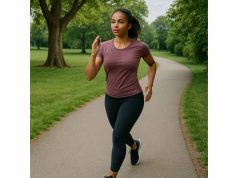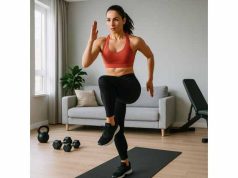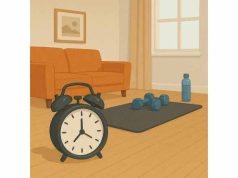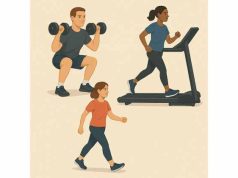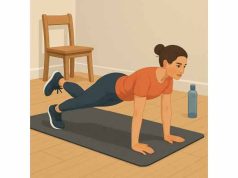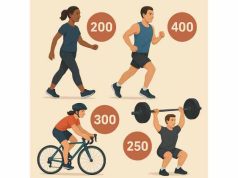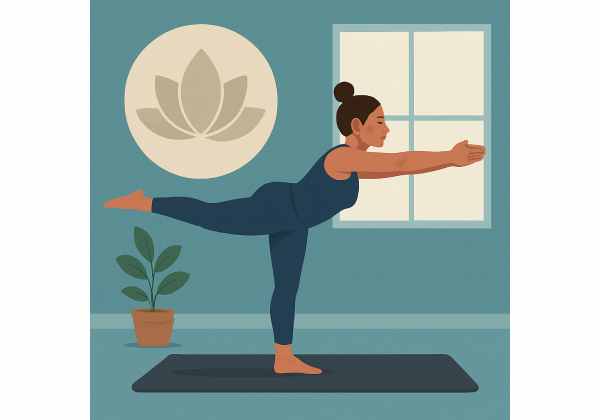
Yoga can support weight loss in practical ways: it adds purposeful movement you can repeat, builds usable strength, improves joint range, and lowers stress that often derails nutrition choices. Because intensity is adjustable—from gentle mobility to vigorous flows—you can match sessions to your energy and schedule. This guide explains which class styles actually raise energy expenditure, how to set intensity without heart-rate gadgets, and how to progress week by week without aching wrists or sore knees. You’ll get a realistic eight-week plan that pairs yoga with steps and simple strength work so the scale moves while you feel better in daily life. For a bigger picture on blending modalities, skim our exercise framework for weight loss first.
Table of Contents
- Why yoga helps weight loss
- Flow types and intensity
- How to progress safely
- Eight-week yoga plan
- Alignment, modifications and safety
- Combining yoga with cardio and strength
- Troubleshooting and plateaus
- Frequently Asked Questions
Why yoga helps weight loss
Yoga does not have to be your “main workout” to be meaningful for weight management. It works by solving several bottlenecks that make fat loss hard—without requiring extreme effort or long gym visits.
It’s repeatable movement.
Weight loss is largely about weekly minutes of activity you can sustain. Gentle to moderate flows provide energy expenditure with low orthopedic cost. That matters if high-impact cardio irritates knees, feet, or the lower back. Because yoga ranges from restorative to vigorous, you can always choose a version that keeps you moving when life is busy or you’re sore from other training.
It protects and builds movement capacity.
Tight ankles, hips, and upper backs make everyday exercise feel awkward. Yoga’s focus on thoracic rotation, hip extension, and ankle dorsiflexion improves your ability to walk briskly, squat, hinge, and press. More comfortable movement makes it easier to hit step targets and lift consistently—two pillars of fat-loss plans.
It strengthens with body weight.
Chaturanga (yoga push-up), plank variations, chair pose, and split-stance postures strengthen the shoulders, trunk, and legs. That strength helps preserve lean mass during a calorie deficit, so more of the weight you lose comes from fat. Stronger shoulders and hips also reduce nagging aches that can cut sessions short.
It moderates stress and sleep.
Cortisol and poor sleep can drive late-night snacking, low energy, and skipped workouts. Yoga’s deliberate breathing and attention to posture turn down the noise of the day. Even short evening practices improve wind-down and make nutrition choices easier the next day.
It teaches pacing and awareness.
Breath-led movement makes you notice effort changes and technical drift. That awareness carries into walking, running, or strength work—you’ll recognize when to back off before form breaks.
A realistic role for yoga in fat loss
Most people do best when yoga is part of a plan that also includes steps and two short strength sessions. Think of yoga as the connective tissue: it keeps you moving between harder days, maintains range and posture, and offers a vigorous option when you choose a faster flow. For guardrails on rate of change, habits, and how to combine modalities safely, review our safe weight-loss basics before you dive in.
Key takeaways
- Consistent, low-impact minutes matter more than heroic, infrequent workouts.
- Mobility gains from yoga make walking and strength sessions more effective.
- Body-weight strength in flows protects muscle in a deficit.
- Breath work and better sleep support appetite control and adherence.
Flow types and intensity
Not all yoga styles stress the body the same way. Choose formats that match your goal and day-to-day energy, then progress within that lane.
Hatha (foundations, steady)
- What it is: Slower pace with longer posture holds and clear alignment cues.
- Why use it: Ideal for beginners and recovery days; great for learning joint positions and breath.
- Fat-loss role: Adds low-to-moderate energy expenditure and significant mobility practice.
Vinyasa / Flow (continuous movement)
- What it is: Breath-linked sequences with frequent transitions (e.g., Sun Salutations).
- Why use it: Easy to scale from light to sweaty; improves work capacity and coordination.
- Fat-loss role: Strong choice for moderate intensity and time-efficient sessions.
Power / Ashtanga (structured, vigorous)
- What it is: More demanding sequences, often with arm balances and repeated vinyasas.
- Why use it: Builds upper-body/trunk endurance; elevates heart rate.
- Fat-loss role: Your “higher-intensity” yoga day—use 1–2×/week if joints and schedule allow.
Yin / Restorative (long holds, down-regulated)
- What it is: Passive or supported stretches held for 2–5+ minutes; emphasis on relaxation.
- Why use it: Excellent for stress relief and range without joint irritation.
- Fat-loss role: Does not burn many calories, but it protects sleep and adherence.
Hot / Heated classes
- What it is: Flows or set sequences in a warm room.
- Why use it: Heat can feel motivating and increase perceived effort.
- Fat-loss role: Sweat is not fat loss; treat heated classes like any other flow. Hydrate, reduce intensity if dizzy.
How to adjust intensity inside any class
- Breath rule: If you cannot keep nasal breathing during easier segments or smooth inhales/exhales during harder segments, you’re going too fast for that day.
- Work/rest ratio: In self-guided flows, alternate 2–3 stronger sequences with 1–2 gentler ones.
- Range vs fatigue: Favor clean range with control over deeper but shaky positions.
Curious how yoga’s energy cost compares with other activities? See our concise look at typical calorie ranges by activity to set expectations. Remember: weekly consistency beats single-class burn.
How to progress safely
Progression in yoga isn’t just “harder poses.” For weight loss, progress means more weekly minutes you can repeat, plus incremental increases in intensity that your joints and tendons tolerate.
Four levers to progress (change one at a time)
- Frequency: Move from 2 to 3 sessions/week, then consider 4.
- Duration: Add 5 minutes to one session per week until you reach 45–60 minutes for your “long flow.”
- Density: Keep class length constant but reduce rest—shorter Child’s Pose breaks, more continuous sequences.
- Complexity/Load: Add strength-biased postures (Chair, Low Lunge, Crescent, Side Plank), longer isometric holds, or light external load (e.g., yoga blocks used as light dumbbells in air-squats or dead-bug presses).
A practical intensity scale (RPE for yoga)
- RPE 3–4 (easy): Unhurried Hatha, Yin, or recovery flow. You can nasal breathe through most of class.
- RPE 5–6 (moderate): Smooth Vinyasa with steady chaturangas; you speak in short sentences after a sequence.
- RPE 7–8 (hard): Power sequences, repeated vinyasas, long isometrics (e.g., 45–60 s Chair), or added cardio finishers.
Progress markers that matter
- Fewer rest breaks to maintain form.
- Same class, lower perceived effort.
- Longer holds without joint discomfort.
- The day after, steps and strength sessions still feel doable.
Wrists, shoulders, and knees: protect the levers
- Wrists: Warm with fist pumps/circles; spread fingers; load through the mound below the index finger and the heel of the hand. Elevate hands on blocks if extension is limited.
- Shoulders: Keep elbows close to ribs in Chaturanga; if shoulders drift forward, drop knees or swap for high-plank holds.
- Knees: Track knee over second/third toe in lunges and Chair; shorten stance if you feel pressure in the front knee.
When to add “cardio inside yoga”
- Use flow blocks of 3–5 minutes where you move continuously through Sun A/B or a lunge sequence; recover with 1–2 minutes of breath-led mobility.
- Keep 1–2 blocks like this on vigorous days. On other days, stay at RPE 3–5 for mobility and decompression.
Prefer a clearer endurance framework? Apply conversational-effort principles from Zone 2 guidance to flows: you should be able to breathe smoothly with short sentences most of the session, peppered with brief harder sequences.
Eight-week yoga plan
Use this as a scaffold; swap days to match your schedule. The plan assumes you also keep a daily steps habit and (ideally) include two short strength sessions per week. Most yoga sessions should sit at RPE 3–6, with one more vigorous day (RPE 6–8) when you feel good.
Global rules
- Change one variable weekly (minutes, density, or a slightly stronger style).
- If joints feel cranky, repeat the week or replace the vigorous day with Hatha/Yin.
- Leave classes feeling refreshed more often than smoked.
Weeks 1–2 (Build the base)
- Day 1 — Hatha Foundations (30–40 min): Emphasize hip openers, ankle mobility, and light core.
- Day 3 — Vinyasa Light (30–35 min): Sun A/B × 2–3 rounds; simple standing series; short floor sequence.
- Day 5 — Restorative/Yin (20–30 min): Glute/hip flexor/calf focus; long exhales.
Weeks 3–4 (Add density, not grind)
- Day 1 — Hatha + Strength holds (35–45 min): Chair 3 × 30–45 s; Crescent 3 × 20–30 s/side; Side Plank variations.
- Day 3 — Vinyasa Moderate (35–45 min): Two 4–5-minute continuous flow blocks separated by 2 minutes of breath/mobility.
- Day 5 — Yin/Recovery (25–35 min): Emphasize T-spine rotation and calves.
Weeks 5–6 (One vigorous day)
- Day 1 — Power Flow (40–50 min): Repeat vinyasas, add plank/knee-to-elbow, optional light jump transitions if joints tolerate.
- Day 3 — Hatha Technique (35–45 min): Balance work (Tree, Warrior III progressions), moderate isometrics.
- Day 5 — Restorative (25–35 min): Down-regulate; prioritize sleep.
Weeks 7–8 (Consolidate and test)
- Day 1 — Vinyasa Threshold (45–55 min): Three 5-minute flow blocks with 2 minutes easy between; end with gentle floor work.
- Day 3 — Hatha Strength (40–45 min): Chair/Crescent/Bridge holds; core finisher (dead bug, hollow variations).
- Day 5 — Yin (25–35 min): Hips and calves; long exhales; legs-up-the-wall to finish.
Optional test at week 8:
- Time a steady 20-minute flow and count complete rounds of your chosen sequence at smooth RPE 5–6. Retest monthly to gauge endurance and technical efficiency.
Before vigorous sessions, skim warm-up and recovery basics and apply a short wrist/shoulder prep. Your long-term advantage is consistency, not maximal sweat.
Alignment, modifications and safety
Yoga should fit your body—not the other way around. Use the principles below to keep joints happy while you accumulate productive minutes.
Wrists and shoulders
- Stacking: In Plank/Chaturanga, shoulders over wrists, elbows at ~45° to ribs.
- Chaturanga options: Knees-down; elevated hands (bench/blocks); swap for eccentric lowers (3–4 seconds) or isometric high-plank holds.
- Down Dog tweaks: Slight bend in knees, focus on a long spine; elevate hands if hamstring tension rounds the back.
Hips and knees
- Knee tracking: In lunges and Chair, knee follows second/third toe. If the inside knee collapses, shorten stance and grip the floor gently with the foot.
- Depth control: Use blocks under hands or reduce range until strength matches mobility. Depth is earned, not forced.
- Pigeon alternatives: Figure-4 on the back or seated variations if front-of-knee pressure appears.
Spine and core
- Neutral over “bend more.” In backbends, lengthen through the chest while keeping ribs down and glutes lightly engaged.
- Bracing: Think gentle belt-tightening around the waist on transitions; breathe “behind” the brace.
Larger bodies and beginners
- Widen stances for space; use blocks liberally; elevate hands to reduce wrist angles.
- Pace with nasal breathing for most of class; mouth-breathing is a cue to downshift.
Hot room considerations
- Hydrate, add sodium if you sweat heavily, and favor smaller ranges as heat rises. Dizziness means it’s time to cool, not push.
For trunk stability that carries into balance and flow, fold in 6–10 minutes of core strength during weight loss weekly: dead bug, side plank, suitcase carry, bird dog.
Combining yoga with cardio and strength
Yoga shines when it complements steps and simple lifting. That mix protects muscle, keeps joints mobile, and raises weekly energy expenditure without burnout.
A balanced week (example)
- Mon: Strength A (squat/row/push) + 10-minute walk
- Tue: Vinyasa moderate (35–45 min)
- Wed: Steps emphasis (two 10–15-minute walks)
- Thu: Strength B (hinge/pull/upper push)
- Fri: Yin/Recovery (25–35 min)
- Sat: Power or longer Vinyasa (40–55 min)
- Sun: Leisure walk/hike
Why this works
- Two strength days preserve lean mass and joint integrity.
- One vigorous and one moderate yoga session challenge capacity.
- A recovery yoga day supports sleep and mobility.
- Steps fill the gaps and maintain background burn.
Nutrition and sleep
- Anchor training days with protein-forward meals and produce; a modest deficit (≈300–500 kcal/day) is easier to maintain alongside training.
- Protect 7–9 hours of sleep—the best recovery tool you have.
If you want a plug-and-play lifting template to pair with your flows, pull exercises from our beginner strength plan and cap sessions at 30–40 minutes. Keep lifting 24–48 hours away from your hardest flow.
Troubleshooting and plateaus
Plateaus happen. The solutions are usually simple and repeatable.
If weight loss stalls
- Audit steps: Did your daily movement drop as classes got harder? Re-establish a baseline (e.g., 7,500–10,000).
- Adjust minutes: Add 5–10 minutes to one flow and one walk this week.
- Tighten meals: Reduce liquid calories and random extras; keep 80–90% of meals repeatable.
If joints ache
- Swap one vigorous class for Hatha or Yin this week.
- Elevate hands, shorten stances, and reduce end-range holds.
- Add 5 minutes of wrist/ankle/hip prep before class.
If energy is low
- Move the vigorous day later in the week; put restorative work before the tightest sleep nights.
- Fuel with carbs before challenging flows; eat a protein-rich meal within a few hours after.
If classes feel easier but the scale won’t budge
- Increase density (more continuous sequences) or frequency (add a short at-home 20-minute flow).
- Consider a modest steps bump (≈1,000/day for 10–14 days).
Mindset for the long game
- Progress is not linear. Repeating a week consolidates technique and confidence.
- Consistency is the real PR: two yoga sessions, two strength sessions, and steady steps beat sporadic “crushers.”
Frequently Asked Questions
Can yoga alone help you lose weight?
Yes—if you practice consistently, manage nutrition, and accumulate weekly minutes. Vigorous flows add meaningful burn; gentle sessions protect sleep and mobility. Many people make the best progress when yoga complements steps and two short strength sessions rather than replacing them.
Which yoga style is best for fat loss?
Vinyasa and Power classes usually deliver the most energy expenditure while building strength and mobility. Hatha builds technique and range; Yin supports recovery and sleep. A weekly mix—one vigorous flow, one moderate, one restorative—works well for most beginners.
How many days per week should I do yoga to lose weight?
Start with 2–3 sessions/week, then consider four as recovery and schedule allow. Keep one session restorative. Progress by adding minutes to one practice, increasing density slightly, or introducing one more continuous flow block on vigorous days.
Is hot yoga better for weight loss?
Not necessarily. Heat increases sweat, not fat loss. Treat hot classes like any other flow: scale sequences to maintain form, hydrate, and stop if dizzy. Choose class style and intensity based on joints, energy, and goals—not room temperature.
Should I do yoga before or after strength training?
If the yoga session is gentle, it pairs well before or after lifting. If it’s vigorous (Power/Vinyasa), separate it from heavy strength by several hours or put it on a different day. Keep at least one full recovery day each week.
Will yoga build muscle?
Yoga builds muscular endurance and some strength, especially in the trunk, shoulders, and quads. For maximal muscle gain or strength, add two short lifting sessions using squats, hinges, pushes, and pulls. Yoga then keeps joints mobile and reduces soreness.
What should I eat before a yoga session for fat loss?
Have a light meal or snack with protein and easy carbs 1–3 hours before (e.g., yogurt and fruit, toast and eggs). After, include 20–40 g of protein plus produce and whole-food carbs. Hydrate well, especially for heated classes.
References
- The impact of yoga on components of energy balance in adults with overweight or obesity: A systematic review — 2022 (Systematic Review)
- Oxygen Consumption and Heart Rate Responses in Different Vinyasa Yoga Sequences — 2023 (Physiology Study)
- Acute Physiologic Effects of Performing Yoga in The Heat on Energy Expenditure, Range of Motion, and Inflammatory Biomarkers — 2020 (RCT, Crossover)
- A randomized trial examining the effect of yoga on dietary lapses and lapse triggers following behavioral weight loss treatment — 2023 (RCT)
- Range of Yoga Intensities From Savasana to Sweating: A Systematic Review — 2020 (Systematic Review)
Disclaimer
This article is educational and not a substitute for personalized medical advice. Speak with your physician or a qualified health professional before starting or modifying exercise or nutrition—especially if you have cardiovascular, metabolic, or orthopedic conditions, are pregnant, or are returning from injury or surgery.
If this guide helped you, consider sharing it with a friend. You’re welcome to follow us on Facebook or X for practical templates and steady, evidence-informed updates.

